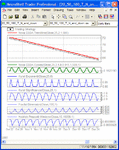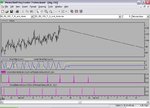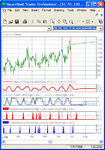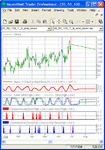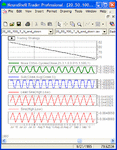This is worthless
1. Your artificial signal is not a down trend but a down line. As a result CSSA produces a small cycle of amplitude < 0.0000001 which is very much expected; it picks up floating point errors in your data as many other indicators do (see plot attached). This cycle is real and there is nothing wrong with that.
To wrap up on this, the small cycle produced is not "CSSA's fault" but is due to your data. CSSA is smart enough to pick it up and the cycle is small enough for you to discount it. As a general rule in trading I strongly suggest that you do sanity checks.
2. To address your artificial problem I suggested that you use QPhase instead but you'll have to generate the signals yourself. Crossovers are the solution. There is no patch, no backward curve fitting of any kind, not even threshold setting or any other silly sauce argument you might come up with; just bare trading through simple indicator crossovers.
Noxa
What i want to say based on my understanding of this problem is based on post 254:
So
1) We have down trend and E0 are generating buy signals and this is a fault
because the small sine cycle is generated
2) To avoid this we find the threshold for QPhase which will filter out those entries.
but this solution don't fix fault but just covers it. It not generic solution,
just a patch for this certain case. So if the an amplitude of this sin will change because of whatever (like changing of slope of the line) we will have a faulty entries again ??? It was for me backward fitting.
Krzysztof
1. Your artificial signal is not a down trend but a down line. As a result CSSA produces a small cycle of amplitude < 0.0000001 which is very much expected; it picks up floating point errors in your data as many other indicators do (see plot attached). This cycle is real and there is nothing wrong with that.
To wrap up on this, the small cycle produced is not "CSSA's fault" but is due to your data. CSSA is smart enough to pick it up and the cycle is small enough for you to discount it. As a general rule in trading I strongly suggest that you do sanity checks.
2. To address your artificial problem I suggested that you use QPhase instead but you'll have to generate the signals yourself. Crossovers are the solution. There is no patch, no backward curve fitting of any kind, not even threshold setting or any other silly sauce argument you might come up with; just bare trading through simple indicator crossovers.
Noxa

